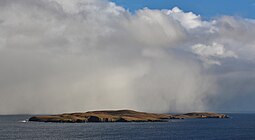Mousa
| Norse name | Mósey (Norwegian: Mosøy) |
|---|---|
| Meaning of name | Old Norse: moor or mossy island |
 A snow shower over Mousa |
|
| Location | |
|
Mousa shown within the Shetland Islands
|
|
| OS grid reference | HU460240 |
| Coordinates | 60°00′N 1°10′W / 60.00°N 1.17°W |
| Physical geography | |
| Island group | Shetland |
| Area | 180 hectares (0.69 sq mi) |
| Area rank | 115= |
| Highest elevation | 55 metres (180 ft) |
| Administration | |
| Sovereign state | United Kingdom |
| Country | Scotland |
| Council area | Shetland Islands |
| Demographics | |
| Population | 0 |
| References | |
Mousa (Old Norse: Mosey "moss island") is a small island in Shetland, Scotland, uninhabited since the nineteenth century. The island is known for the Broch of Mousa, an Iron Age round tower, and is designated as a Special Protection Area for storm-petrel breeding colonies.
Mousa lies a mile off the east coast of Mainland Shetland in the parish of Dunrossness about 15 miles (24 km) south of Lerwick. Almost divided in two by inlets, East and West Hams, the island is 1.5 miles (2.4 km) long and almost 1-mile (1.6 km) in maximum width. Geologically beds of hard sandstone alternate with muddy limestones that weather to produce fertile soil. A quarry provided flagstones for Lerwick.
Mousa’s fertile soil supports a rich diversity of plants, including sheep’s-bit and creeping willow in the herb-rich grassland, despite the wind, salt spray and grazing by sheep.
The Norse tended to consider an island to be something that they could circumnavigate, and this included being able to drag a boat over land. Thus Mousa was considered two islands, namely North Isle and South Isle.
Mousa Broch is the best preserved Iron Age fortification in the British Isles. The 2000-year-old round tower stands above a rocky shoreline, one of a pair of brochs guarding Mousa Sound. They may be part of a chain of brochs in this part of Shetland, visible from each other as beacons. The other of the "pair", at Burland on the Mainland is far less well preserved. Many brochs were the focus of a settlement, but there has never been a full archaeological investigation to confirm this at Mousa. It was cleared out in 1860 and 1919. Mousa has survived intact to such a height and is thought to never have been much higher than it is today. It escaped stone gathering for nearby stone walls and croft houses (now ruined).
Mousa is mentioned in the Orkneyinga Saga as being used as a place of defence during invasions, as well as a lovers' hideout.
...
Wikipedia

